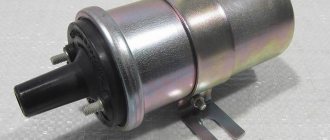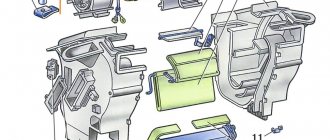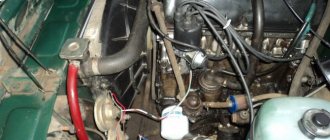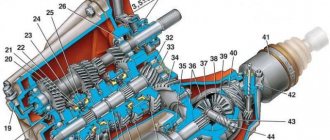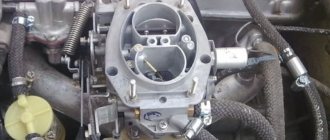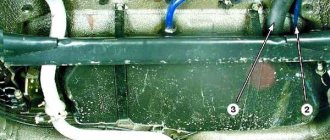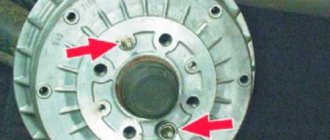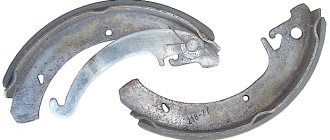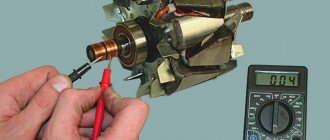A manual for the car owner: the principle of operation of the cooling device in the car, diagram for VAZ 2107 (Zhiguli), 2114 (Lada Samara) and 2115. How to check its operation, video.
List of article contents:
- How the thermostat works in a car
- Thermostat diagram VAZ 2107, 2114, 2115
- How to correctly determine that a device is in working condition
- Car thermostat price
The thermostat is a cooling system device that is found in all cars (in the standard version with a diameter of five centimeters, located between the engine and radiator) equipped with a liquid engine cooling system.
This is a device that allows you to maintain a constant engine temperature due to the operation of thermostats or due to a phase transition. Sometimes you can see thermostats with thermal insulation, which can reduce heat or cold loss. The most common one, used by everyone, young and old, is the refrigerator.
The thermostat performs the function of blocking the radiator from the flow of coolant (antifreeze), actually giving the engine time to warm up. Also, such a simple mechanism helps reduce wear on the car engine. It is closed while the engine temperature is normal, as soon as it reaches a critical point within ninety or ninety-five degrees Celsius, the damper in the thermostat opens and allows coolant to enter the engine and normalize its temperature.
You can also observe the operation of the device at home. You just need to place the thermostat in a container filled with ordinary water and put it on the stove to heat up. As the temperature of the water in the pan increases, you will be able to see the valve on the thermostat open by about two centimeters. To conduct the experiment, it is better to take a new one, and not remove it from your own or someone else’s car.
How the thermostat works in a car
There are many factors that can cause problems, but corrosion is the most common. When the valve is constantly in the open position, engine cooling fluid will always flow into the radiator before entering the engine, which means the engine needs more time to reach critical temperature. And when the thermostat valve is constantly closed, the engine does not cool down and continues to gain temperature, accordingly, the car “boils” and you cannot continue driving it until the engine cools down. Experts and auto mechanics recommend that motorists replace the old one with a new one approximately every two years. Read how to change the thermostat in a VAZ 2110-2111 car.
Features of testing on VAZ series cars
VAZ cars continue to be a truly “people's” vehicle. Let's look at how to check the thermostat on a car of this brand.
To begin with, we note that on all models of the Volzhsky Automobile Plant (VAZ 2107, 2114, 2109, 2110, 2114 and others), the principle of checking the thermostat is identical. The only thing that can change is the opening and closing temperature. But this information can be found in the instructions for your car.
As in previous cases, verification is carried out using two methods.
How to correctly determine that the device is in working condition?
We warm up the engine to such a temperature that the needle does not reach the critical value, and turn it off. We open the hood, find a hose on top of the radiator (a black rubber hose with a metal clamp at the end) and the same one on the bottom. Then, very carefully, they may be quite hot, touch them. If one of them becomes hot, and the other is still cold, and the sensor shows a high engine temperature, this means that most likely the liquid does not enter the engine, but is retained in the radiator, and you need to change the thermostat to a new one.
There is another way of checking, better known as “folk”. It echoes the “experiment” that was described above, to observe the process of the thermostat, only this time you will have to put the thermostat, the functionality of which you doubt, removed from your car, into a container with water, and then the procedure is repeated as Once the water reaches a temperature of 87–90 degrees, the valve should open, however, if this does not happen, then the thermostat is no longer suitable for operation. It is also worth remembering that different thermostats may have different critical valve opening temperatures, so when purchasing a new one, check this with the seller. Since it is no secret to the driver that it is impossible to install a thermostat in a car that has a high valve opening temperature - the engine will not cool.
Video, checking the thermostat VAZ 2101-2107 and Tama (Toyota):
code Luzar LT 0101
OEM number: 2101-1306010 2101-1306010-82 21010-1306010-82 21010-130601002
Opening temperature, ?С: 80°С
Where can I buy
Applicability for vehicles
Brand name – LT – LuzarThermostat
Thermostats are necessary to direct the flow of coolant in the cooling system of automobile engines, thereby regulating the temperature of the coolant.
- when the temperature rises (usually at ≈80ºC), the main thermostat valve opens while the bypass valve closes;
- the radiator is included in the cooling circuit;
- the coolant temperature drops;
- When the temperature decreases, the reverse process occurs.
VAZ 2101 thermostat malfunctions and their symptoms
There can only be two breakdowns of a thermostat: mechanical damage, as a result of which the device body has lost its tightness, and jamming of the main valve. There is no point in considering the first malfunction, since it happens extremely rarely (as a result of an accident, inept repair, etc.). In addition, such a breakdown can be determined even by visual inspection.
Main valve jamming occurs much more often. Moreover, it can jam in both the open and closed or middle positions. In each of these cases, the signs of its failure will be different:
- The engine takes a very long time to warm up. According to the VAZ 2101 passport data, warming up the power plant to operating temperature should occur in 4–7 minutes, depending on the ambient temperature. If the motor does not settle within this time, most likely the main valve is “stuck” in the open position. In this case, from the moment the engine starts, the coolant passes in a large circle, that is, through the radiator, where its temperature decreases. To confirm or refute your suspicions, you need to start a cold engine, wait 1-2 minutes and touch the rubber hose connecting the thermostat and the upper radiator tank with your hand. If it is warm, the valve is definitely stuck in the open or middle position. It is possible to continue operating the car in such cases, but there is no guarantee that the valve will not move in the opposite direction and “stick”, blocking the flow of coolant to the radiator;
If the upper radiator hose becomes warm after 1-2 minutes of engine operation, the main thermostat valve is stuck open. - the engine warms up in less than 4 minutes, and then there is obvious overheating, confirmed by the readings of the coolant temperature sensor. In this case, the valve is jammed in the closed position. To confirm, let's turn to the same pipe running from the thermostat to the top of the radiator. If it remains cold after four minutes, the thermostat is faulty. You cannot continue driving with such a breakdown, otherwise the engine will fail ;
- the temperature of the operating power unit is unstable. If the valve is stuck in an intermediate position, it is almost impossible to diagnose a malfunction of the thermostat without dismantling it. But if you notice that the needle on the temperature sensor constantly changes its position (even if the sensor and device are known to be working), the thermostat is probably the reason for this. Such a breakdown does not pose a serious threat to the engine, but it must be repaired as soon as possible.
Why does the thermostat fail and is it possible to restore its functionality?
Practice shows that even the most expensive branded thermostat lasts no more than four years. As for cheap analogues, problems with them can arise even after a month of use. The main causes of device breakdowns include:
- use of low-quality coolant;
- presence of oxidation products, water, dirt in the cooling system;
- manufacturing defects.
From personal experience, I can give an example of using cheap antifreeze, which I bought for some time on the car market in bulk from a “trusted” seller. Having discovered signs of the thermostat being stuck in the open position, I decided to replace it. After completing the repair work, I brought the faulty part home to check and, if possible, bring it into working condition by boiling it in engine oil (why, I will tell you later). When I examined the inner surface of the device, thoughts about using it ever again disappeared from me. The walls of the part were covered with multiple shells, indicating active oxidative processes. The thermostat, naturally, was thrown away, but the misadventures did not end there. After 2 months, there were signs of a broken cylinder head gasket and coolant entering the combustion chambers. But that's not all. When removing the head, cavities were found on the mating planes of the cylinder head, block, as well as on the windows of the cooling jacket channels. At the same time, a strong smell of ammonia emanated from the engine. According to the master who performed the “autopsy,” I am not the first and far from the last who had or will have to regret saving money on coolant.
As a result, I had to buy a gasket, a block head, pay for its grinding, as well as all the dismantling and installation work. Since then, I have avoided the car market, buying only antifreeze, and not the cheapest one.
Poor quality coolant corrodes cooling system elements
Corrosion products and various debris most often cause the main valve to jam. They are deposited day after day on the inner walls of the case and at some point begin to interfere with its free movement. This is how “sticking” occurs.
As for marriage, it occurs quite often. Not a single car shop, not to mention sellers at the car market, will give a guarantee that the thermostat you purchased will open and close at the temperature indicated in the passport, and indeed work correctly. That's why ask for a receipt and don't throw away the packaging in case something goes wrong. Moreover, before installing a new part, do not be lazy to check it.
Deposits of dirt and oxidation products cause the main valve to jam
A few words about boiling the thermostat in oil. This method of repair has been practiced by our car owners for quite a long time. There is no guarantee that the device will work like new after such simple manipulations, but it’s worth a try. I conducted similar experiments twice, and in both cases everything worked out. I would not recommend using a thermostat restored in this way, but, believe me, it can come in handy as a spare part thrown into the trunk “just in case.” In order to try to restore the device we will need:
- motor oil (not used);
- a metal container that would hold the thermostat so that it is completely covered with oil;
- gas or electric stove;
- WD-40 aerosol or equivalent;
- carburetor cleaning fluid.
The first step is to generously treat the inner walls of the thermostat and the valve mechanism with carburetor cleaning fluid. After waiting 10–20 minutes, immerse the device in a container, pour in oil so that it covers the part, and place the container on the stove. The thermostat needs to be boiled for at least 20 minutes. After boiling, let the oil cool, remove the thermostat, drain the oil from it, and wipe with a dry cloth. After this, you can treat the valve mechanism with WD-40 aerosol. Upon completion of the restoration work, the temperature controller must be checked in the manner described below.
What to do if the thermostat is stuck closed on the road
On the road, a stuck thermostat valve in a small circle can cause a lot of troubles, ranging from a disrupted trip to the need for urgent repairs. However, in some cases these troubles can be avoided. Firstly, it is important to notice the increase in coolant temperature in time and prevent critical overheating of the power plant. Secondly, if you have a set of keys and there is an auto shop nearby, the thermostat can be replaced. Thirdly, you can try to wedge the valve. And finally, you can slowly drive home.
For greater understanding, I will again give an example from my experience. One frosty winter morning, I started my “penny” and calmly went to work. Despite the frost, the engine started easily and warmed up quite quickly. Having driven about 3 kilometers away from the house, I suddenly noticed streams of white steam coming from under the hood. There was no need to go through the options of what was happening. The temperature sensor needle has exceeded 130 oC. Having turned off the engine and pulled over to the side of the road, I opened the hood. Guess about a malfunction of the thermostat were confirmed by the swollen expansion tank and the cold pipe of the upper radiator tank. The keys were in the trunk, but the nearest auto shop was at least 4 kilometers away. Without thinking twice, I took the pliers and hit the thermostat housing with them several times. Thus, as the “experienced” say, you can wedge the valve. It really helped. Within a few seconds of starting the engine, the top pipe was hot. This means that the thermostat has opened wide. Rejoicing, I got behind the wheel and calmly drove to work.
Returning home, I no longer thought about the thermostat. But as it turned out, it was in vain. Having driven halfway, I noticed the temperature sensor. The needle was again approaching 130 oC. With “knowledge of the matter,” I again began to knock on the thermostat, but there was no result. Attempts to wedge the valve continued for about an hour. During this time, of course, I was frozen to the bone, but the engine also cooled down. In order not to abandon the car on the highway, it was decided to slowly drive home. Trying not to overheat the engine by more than 100 oC, I drove no more than 500 m with the heater turned on at full power and turned it off, letting it cool. I got home in about an hour and a half, having traveled about five kilometers. The next day I replaced the thermostat myself.
Design of LUZAR thermostats
The terms should be distinguished:
- thermostat in a broad sense (car part, thermostat in a housing, thermostat as a “function”)
- thermostat in the “commodity” sense (a replaceable part of the thermostat, can be either a thermostat in the housing or a thermoelement; what is sold as a thermostat for a given machine)
- thermoelement (“working” part of the thermostat, in some cases may coincide with the name of the thermostat in the “commodity” sense)
- temperature sensor (the executive part of the thermostat is part of the thermoelement; it is a brass cylinder with a filler that expands when heated)
An automobile thermostat consists of a temperature sensor, which is a brass cylinder with a filler (technical paraffin or thermal wax), which expands when heated, with a rod on which spring-loaded plates of the main and bypass valves are placed; the temperature sensor is rigidly fixed to the frame, through which the thermoelement can be installed in the thermostat housing. The valve discs have rubber seals.
Automotive thermostats can be cased or uncased, depending on the design laid down by the designer of the engine.
Design image
- modern automotive industry, with the increasing complexity of automobile engines, is switching to the use of electronic thermostats, where temperature control is carried out by sensors, and the thermostat valves are controlled by micromotors (LUZAR does not produce electronic thermostats)
- Many modern engines have not one, but two or more thermostats - for non-uniform temperature control in different parts of the engine.
Advantages of LUZAR thermostats
- Computer dosage of thermal wax LUZAR thermostats have thermal sensors filled using special equipment, which guarantees high accuracy of operation.
- Patented thermal sensor design To eliminate the possibility of a “breakthrough” of thermal wax from the thermal sensor body (which, according to statistics, is the most common cause of thermostat failure), LUZAR changed the configuration of the sealing gasket in the rod-thermal wax-cylinder interface. With increasing pressure, which expands when heated, the thermal wax gasket design - thanks to its specific geometry - forms an increased volume of rubber precisely in places where the thermal wax “breakthrough” may occur. This also required changing the geometry of the temperature sensor housing (“cylinder”).
- Rubberized valves We have eliminated the cause of insufficient tightness of the thermoelement - the metal-to-metal interface between the metal frame of the thermoelement and the metal valve plate - by using a rubber sealing gasket on the valve plate. Thus, LUZAR thermostats provide faster engine warm-up in winter (which is so important in Russian conditions climate).
- 100% control of thermoelements Each thermoelement is tested for temperature, height and response speed - carried out in special baths with cells.
- Warranty 2 years or 125,000 km. Mandatory certification In the event of a breakdown, you can easily replace the purchased thermostat through a retail store - just return it with a warranty card and a description of the defect. All products are certified according to the international quality management system ISO 9001 TUV and have GOST-R certificates of conformity.
How to check a thermostat when purchasing
When purchasing a new thermostat, blow into the fitting. This will ensure that the fitting is closed as tightly as possible when cooled.
Although this does not guarantee 100% quality, it will at least partially protect you from defects. Unfortunately, there are many defective thermostats on the market now.
Knowing how to check a thermostat, you can always identify a malfunction and avoid damage to the power unit.
Please remember that ignoring failures of this device can lead to engine overheating and failure. The result is even greater costs.

